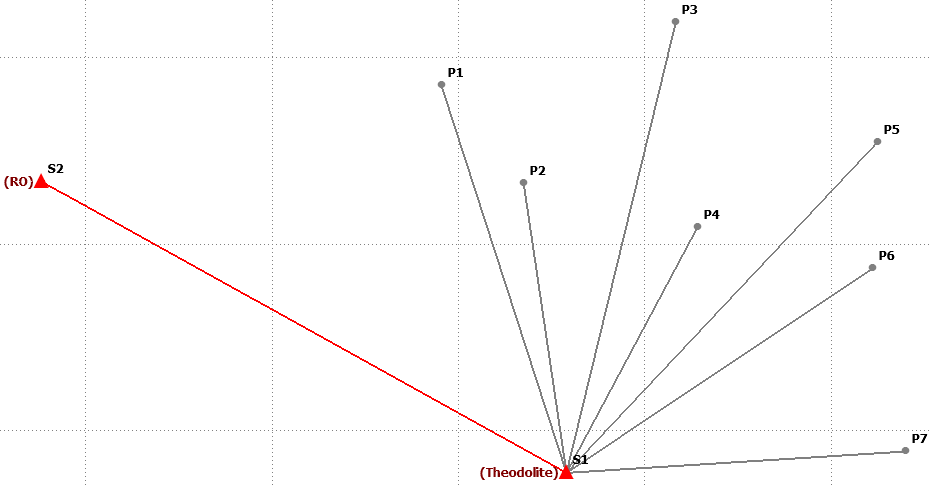Calculating Coordinates of Unknown Points
Terminology
| Total station: | A survey instrument that measures angles and distances and records the information electronically. |
| Known point: | A location, with a permanent ground marker, that has known coordinates and elevation. |
| Horizontal direction (reading): | The angular measurement recorded when observing to any point. |
| Horizontal angle: | The difference between two measured directions. |
| Reference Object (RO): | A known point that is used as an initial sight for orientation when measuring horizontal angles and "directions". |
Overview
The most common method is to set up the total station at a known point (S1 in the diagram below) and measure the directions and distances to the unknown points (P1 to P7).
This, in itself, is not good enough because the orientation (in other words the relationship between the angular measurements and grid North) is not defined.
To overcome this, a horizontal reading is made to a known point (S2). The true bearing (the direction in terms of grid north) can be calculated between S1 and S2. This reference line provides a means of calculating the true bearings to all the unknown points.
S2 is called a Reference Object (or RO) and is typically the first point that is observed from a set up. The surveyor can control the actual horizontal reading to the first observed point. All subsequent horizontal directions are relative to this setting. Most commonly the horizontal reading to the RO is set to zero.

To record an observation, the surveyor points the theodolite to the target (which will be a prism in the case of a total station) and with the press of a button can measure the horizontal angle and distance to the target (we will ignore vertical angles for this discussion). I call the electronic recording of this an "Observation record".
The recording of other information (that typically requires keyboard entry) is captured in a "Code record".
For example, the name of the RO station is often defined in a Code record. When the surveyor sets the horizontal reading to the RO:
- He can record it as an Observation record.
- He can record it as a Code record (the information is keyed in).
- He can choose not to record the reading (if he always sets the same value).
Although the second option sounds clumsy, it is often used, because the name of the RO needs to be input as a Code record anyway. Typically, a Code record can store several values - so entering 0.00 (as the horizontal reading to the RO) at the same time as entering the station name of the RO is only a little extra effort.
Often the RO may simply be a target (not a prism) so the distance cannot be measured (and is not needed). Recording the reading to the RO as an Observation record also has the disadvantage of grouping known and unknown points together.